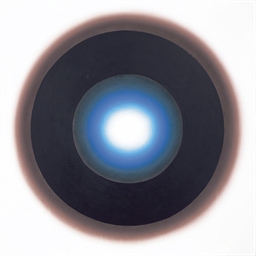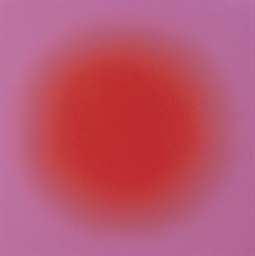Property from a Private European Collection25Wojciech FangorM 91signed, titled and dated 'FANGOR M 91 1967' on the reverse oil on canvas 168 x 177.5 cm (66 1/8 x 69 7/8 in.) Painted in 1967. This work will be included in the forthcoming catalogue raisonné, being prepared by the Estate of Wojciech Fangor Full CataloguingEstimate £200,000 - 300,000 ♠ Place Advance BidContact Specialist Kate Bryan Specialist, Head of Evening Sale +44 20 7318 4026 kbryan@phillips.com
In Short 'He [Fangor] is the great romantic of op art, working not by rule but by a combination of intuition and experiment, appealing not to reason but to our yearning toward the mysterious.' —John Canaday Painted by one of the most prolific Polish artists of the 20th Century, M 91 exemplifies Wojciech Fangor’s spectacular ability to achieve luminosity and movement. Created at the dawn of a nearly three-decade long tenure living in the United States, the boldly painted waves of M 91 are evidence of the artist’s deft mastery of brush and hue. Defined by its deep, meandering movement, and its distinct chromatic intensity, the work notably echoes Fangor’s large-scale M 74 residing at the Solomon R. Guggenheim Museum, New York, which was similarly executed at the artist’s Madison, New Jersey studio. For both works, the titles follow a formulaic logic tracing Fangor’s geographical whereabouts – ultimately relating to their place of execution. ‘Circles and waves are useful’, Fangor said to Hans Ulrich Obrist, ‘because they are deprived of angles and have continuous structure’.i In M 91, rich hued waves transition softly and edgelessly from blue to indigo to black. Wojciech Fangor M 74, 1969, oil on canvas, Solomon R. Guggenheim Museum New York. Image: Reproduced with the permission of The Fangor Estate. Born in 1922, Fangor studied at Warsaw’s Academy of Fine Arts before embarking on an artistic career which would span more than seventy years. Between 1945 and 1956, Fangor’s artistic output was aesthetically aligned with the hyperrealist style of the Socialist Realists, producing works which notably depicted the achievements of the workers in the Polish People’s Republic — exemplified by Postacie, 1950. In the mid-1950s, Fangor began shifting away from figuration and to veer towards theories of colour and space, unaware of the contemporary art scenes in Europe and the United States that were led by the Optical Art and Colour Field movements. Although the artist’s painterly practice was visually aligned with these artistic currents, Fangor developed it on his own as early as 1956. ‘I did not know that I was an op artist’, the artist explained, ‘[the] op movement connected with me’.ii Wojciech Fangor Postacie, 1950, oil on canvas, Museum Sztuki, Łódź. Image: Muzeum Sztuki, Łódź and reproduced with permission of The Fangor Estate. Influences of Paul Signac Pablo Picasso and Fernand Léger are present in Fangor’s early experiments with abstraction. From 1954-1956, Fangor began collaborating with architects and members of the Artistic and Research Workshop at the Warsaw Academy of Fine Arts, then headed by a former student of Le Corbusier. This collaboration and focus on architecture made the artist more aware of the importance of space and resulted in the evolution of Fangor’s scientific concepts, notably on how to create an illusion of space beyond the confines of the canvas with an emphasis on the structure of forms and an interactive relationship between the viewer and pictorial field. Wojciech Fangor in Paris, 1964 Image: Courtesy of Magdalena Fangor and reproduced with the permission of The Fangor Estate. Path to Abstraction 'When I was fourteen years old I constructed my first telescope and was very impressed with the image of the object in and out of focus and spectacular chromatic alteration. My involvement in optics and astronomy was not based upon scientific but visual phenomena.' —Wojciech Fangor Furthermore, Fangor’s lifelong fascination with astronomy and the cosmos was instrumental in developing his ‘focus on exploring space as a fundamental aspect of the surrounding world’, as well as his ‘astronomical observations of planets, cosmic space, and colors inspired the artist to search for colour nuances and color transitions devoid of sharp edges within abstract compositions on canvas’.iii His rigorous investigation of spatial concepts and colour, begun in 1957, was materialised for the first time the following year at Woj
Property from a Private European Collection25Wojciech FangorM 91signed, titled and dated 'FANGOR M 91 1967' on the reverse oil on canvas 168 x 177.5 cm (66 1/8 x 69 7/8 in.) Painted in 1967. This work will be included in the forthcoming catalogue raisonné, being prepared by the Estate of Wojciech Fangor Full CataloguingEstimate £200,000 - 300,000 ♠ Place Advance BidContact Specialist Kate Bryan Specialist, Head of Evening Sale +44 20 7318 4026 kbryan@phillips.com
In Short 'He [Fangor] is the great romantic of op art, working not by rule but by a combination of intuition and experiment, appealing not to reason but to our yearning toward the mysterious.' —John Canaday Painted by one of the most prolific Polish artists of the 20th Century, M 91 exemplifies Wojciech Fangor’s spectacular ability to achieve luminosity and movement. Created at the dawn of a nearly three-decade long tenure living in the United States, the boldly painted waves of M 91 are evidence of the artist’s deft mastery of brush and hue. Defined by its deep, meandering movement, and its distinct chromatic intensity, the work notably echoes Fangor’s large-scale M 74 residing at the Solomon R. Guggenheim Museum, New York, which was similarly executed at the artist’s Madison, New Jersey studio. For both works, the titles follow a formulaic logic tracing Fangor’s geographical whereabouts – ultimately relating to their place of execution. ‘Circles and waves are useful’, Fangor said to Hans Ulrich Obrist, ‘because they are deprived of angles and have continuous structure’.i In M 91, rich hued waves transition softly and edgelessly from blue to indigo to black. Wojciech Fangor M 74, 1969, oil on canvas, Solomon R. Guggenheim Museum New York. Image: Reproduced with the permission of The Fangor Estate. Born in 1922, Fangor studied at Warsaw’s Academy of Fine Arts before embarking on an artistic career which would span more than seventy years. Between 1945 and 1956, Fangor’s artistic output was aesthetically aligned with the hyperrealist style of the Socialist Realists, producing works which notably depicted the achievements of the workers in the Polish People’s Republic — exemplified by Postacie, 1950. In the mid-1950s, Fangor began shifting away from figuration and to veer towards theories of colour and space, unaware of the contemporary art scenes in Europe and the United States that were led by the Optical Art and Colour Field movements. Although the artist’s painterly practice was visually aligned with these artistic currents, Fangor developed it on his own as early as 1956. ‘I did not know that I was an op artist’, the artist explained, ‘[the] op movement connected with me’.ii Wojciech Fangor Postacie, 1950, oil on canvas, Museum Sztuki, Łódź. Image: Muzeum Sztuki, Łódź and reproduced with permission of The Fangor Estate. Influences of Paul Signac Pablo Picasso and Fernand Léger are present in Fangor’s early experiments with abstraction. From 1954-1956, Fangor began collaborating with architects and members of the Artistic and Research Workshop at the Warsaw Academy of Fine Arts, then headed by a former student of Le Corbusier. This collaboration and focus on architecture made the artist more aware of the importance of space and resulted in the evolution of Fangor’s scientific concepts, notably on how to create an illusion of space beyond the confines of the canvas with an emphasis on the structure of forms and an interactive relationship between the viewer and pictorial field. Wojciech Fangor in Paris, 1964 Image: Courtesy of Magdalena Fangor and reproduced with the permission of The Fangor Estate. Path to Abstraction 'When I was fourteen years old I constructed my first telescope and was very impressed with the image of the object in and out of focus and spectacular chromatic alteration. My involvement in optics and astronomy was not based upon scientific but visual phenomena.' —Wojciech Fangor Furthermore, Fangor’s lifelong fascination with astronomy and the cosmos was instrumental in developing his ‘focus on exploring space as a fundamental aspect of the surrounding world’, as well as his ‘astronomical observations of planets, cosmic space, and colors inspired the artist to search for colour nuances and color transitions devoid of sharp edges within abstract compositions on canvas’.iii His rigorous investigation of spatial concepts and colour, begun in 1957, was materialised for the first time the following year at Woj















Testen Sie LotSearch und seine Premium-Features 7 Tage - ohne Kosten!
Lassen Sie sich automatisch über neue Objekte in kommenden Auktionen benachrichtigen.
Suchauftrag anlegen